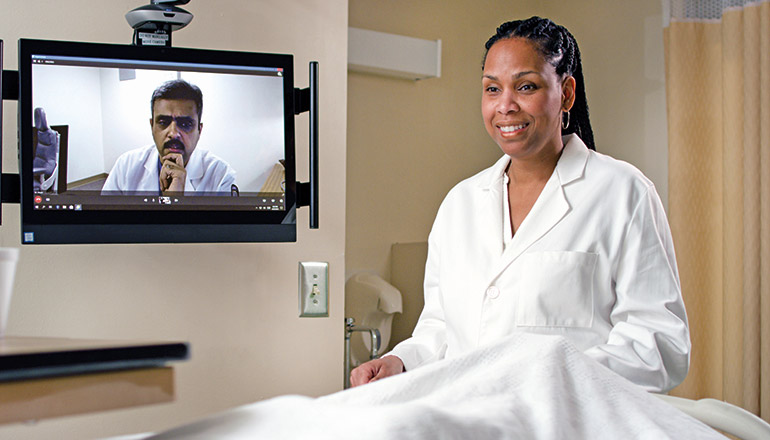High Tech Delivers Critical Capabilities for Patients in Monroe
In 2019 Ochsner LSU Health Shreveport — Monroe Medical Center found new ways to leverage technology that significantly enhance its capabilities to effectively treat patients in intensive care and surgical settings.

Dr. Ammar Alqaid (on screen), Shreveport Internal Medicine, and Dr. Janice Ford, Monroe Internal Medicine, use teleICU capabilities for patients at Ochsner LSU Health Shreveport — Monroe Medical Center.
The first: a teleICU program expanding the number of intensive care and specialty physicians available to patients. The system utilizes two-way audio and video connections to connect with clinicians at the Academic Medical Center in Shreveport. Through the teleICU platform, the local medical team in Monroe can collaborate with Shreveport physicians to increase the timeliness and level of care.
Sixteen ICU rooms and a consultation room at the Monroe Medical Center are now equipped with the two-way teleICU monitors, allowing additional off-site specialty physicians to perform rounds, virtually, on patients. The program was designed in collaboration with the established teleICU program at Ochsner Health. It provides patients with access to critical care specialists, increasing the opportunity to remain in their home community for their medical care — and reducing the need for a potential transfer to Shreveport, some 100 miles away. The system can also reduce response time for patient care decisions and shorten the length of the hospital stay.
In 2019 Monroe Medical Center also launched a new Hybrid Operating Room (OR). The $3 million Hybrid OR provides a single surgical workspace that combines imaging equipment with a multifunctional surgical table, allowing the medical team to treat patients needing multiple surgical specialties and diverse imaging in a single space. The Hybrid OR makes it possible to increase the range of procedures for both minimally invasive and conventional open surgical procedures. In addition, it expands the function of a traditional catheterization lab to diagnose and treat cardiovascular disease. Allowing clinicians to diagnose and treat in a single location can improve patient safety by reducing risk and delays.
